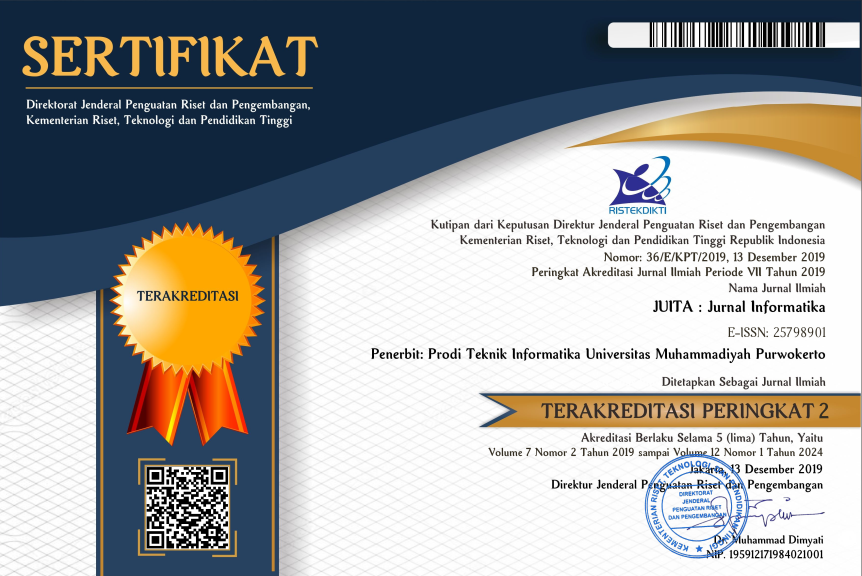Image Classification On Garutan Batik Using Convolutional Neural Network with Data Augmentation
Abstract
Keywords
References
[1] S. Suhartini, N. A. Mahbubah, and M. Basjir, “MARKETING STRATEGY DESIGN BASED ON INFORMATION TECHNOLOGY IN BATIK SMALL AND MEDIUM-SIZED ENTERPRISES IN INDONESIA,” Eastern-European J. Enterp. Technol., vol. 6, no. 13–114, pp. 39–48, 2021, doi: 10.15587/1729-4061.2021.244137.
[2] Y. Y. Sunarya and B. Anas, “The priangan batik in the constellation of modern aesthetics,” J. Vis. Art Des., vol. 6, no. 1, pp. 9–16, Jan. 2014, doi: 10.5614/itbj.vad.2014.6.1.2.
[3] J. Qin, W. Pan, X. Xiang, Y. Tan, and G. Hou, “A biological image classification method based on improved CNN,” Ecol. Inform., vol. 58, p. 101093, 2020, doi: 10.1016/J.ECOINF.2020.101093.
[4] G. Zhou, W. Zhang, A. Chen, M. He, and X. Ma, “Rapid detection of rice disease based on FCM-KM and faster R-CNN fusion,” IEEE access, vol. 7, pp. 143190–143206, 2019, doi: 10.1109/ACCESS.2019.2943454.
[5] X. Lei, H. Pan, and X. Huang, “A dilated CNN model for image classification,” IEEE Access, vol. 7, pp. 124087–124095, 2019, doi: 10.1109/ACCESS.2019.2927169.
[6] S. Arya and R. Singh, “A Comparative Study of CNN and AlexNet for Detection of Disease in Potato and Mango leaf,” 2019 Int. Conf. Issues Challenges Intell. Comput. Tech., vol. 1, pp. 1–6, 2019, doi: 10.1109/ICICT46931.2019.8977648.
[7] S. Baranwal, S. Khandelwal, and A. Arora, “Deep learning convolutional neural network for apple leaves disease detection,” Proc. Int. Conf. Sustain. Comput. Sci. Technol. Manag. (SUSCOM), Amity Univ. Rajasthan, Jaipur-India., 2019, doi: 10.2139/ssrn.3351641.
[8] A. Ramcharan, K. Baranowski, P. McCloskey, J. Ahmed, B., Legg, and D. P. Hughes, “Deep learning for image-based cassava disease detection,” Front. Plant Sci., vol. 8, p. 1852, 2017, doi: 10.3389/fpls.2017.01852.
[9] J. Chaki and N. Dey, A beginner’s guide to image shape feature extraction techniques. CRC Press Taylor & Francis Group, 2019.
[10] L. Perez and J. Wang, “The effectiveness of data augmentation in image classification using deep learning,” arXiv Prepr. arXiv1712.04621, 2017, doi: 10.48550/arXiv.1712.04621.
[11] M. A. Khan, T. Akram, M. Sharif, K. Javed, M. Raza, and T. Saba, “An automated system for cucumber leaf diseased spot detection and classification using improved saliency method and deep features selection,” Multimed. Tools Appl., vol. 79, no. 25–26, pp. 18627–18656, Jul. 2020, doi: 10.1007/S11042-020-08726-8.
[12] M. Kashif et al., “Detection of viruses in sweetpotato from Honduras and Guatemala augmented by deep-sequencing of small-RNAs,” Plant Dis., vol. 96, no. 10, pp. 1430–1437, 2012, doi: 10.1094/PDIS-03-12-0268-RE.
[13] C. Uswatun Khasanah, E. Utami, and S. Raharjo, “Implementation of Data Augmentation Using Convolutional Neural Network for Batik Classification,” in In 2020 8th International Conference on Cyber and IT Service Management (CITSM), Oct. 2020, pp. 1–5, doi: 10.1109/CITSM50537.2020.9268890.
[14] M. A. Rasyidi and T. Bariyah, “Batik pattern recognition using convolutional neural network,” Bull. Electr. Eng. Informatics, vol. 9, no. 4, pp. 1430–1437, Aug. 2020, doi: 10.11591/eei.v9i4.2385.
[15] D. G. T. Meranggi, N. Yudistira, and Y. A. Sari, “Batik Classification Using Convolutional Neural Network with Data Improvements,” JOIV Int. J. Informatics Vis., vol. 6, no. 1, pp. 6–11, Mar. 2022, doi: 10.30630/joiv.6.1.716.
[16] I. M. A. Agastya and A. Setyanto, “Classification of Indonesian batik using deep learning techniques and data augmentation,” in In 2018 3rd international conference on information technology, information system and electrical engineering (ICITISEE), Nov. 2018, pp. 27–31, doi: 10.1109/ICITISEE.2018.8720990.
[17] M. A. Rasyidi, R. Handayani, and F. Aziz, “Identification of batik making method from images using convolutional neural network with limited amount of data,” Bull. Electr. Eng. Informatics, vol. 10, no. 3, pp. 1300–1307, Jun. 2021, doi: 10.11591/eei.v10i3.3035.
[18] B. Pasaribu, Y. Latief, and S. Riantini L, “Development of Risk-Based Standardized Work Breakdown Structure (WBS) to Improve Quality Planning of Drainage Construction Work Development of Risk-Based Standardized Work Breakdown Structure (WBS) to,” IOP Conf. Ser. Earth Environ. Sci., vol. 258, no. 1, p. 12054, 2019, doi: 10.1088/1755-1315/258/1/012054.
[19] E. Siami-Irdemoosa, S. R. Dindarloo, and M. Sharifzadeh, “Work breakdown structure ({WBS}) development for underground construction,” Autom. Constr., vol. 58, pp. 85–94, 2015, doi: 10.1016/j.autcon.2015.07.016.
[20] R. C. Tausworthe, “The work breakdown structure in software project management,” J. Syst. Softw., vol. 1, pp. 181–186, 1979, doi: 10.1016/0164-1212(79)90018-9.
[21] L. Fitriani, P. Hakim, and R. M. Al Haq, “E-Commerce For Village Information System Using Agile Methodology,” J. Online Inform., vol. 7, no. 1, pp. 89–96, 2022, doi: 10.15575/join.v7i1.825.
[22] L. Fitriani, S. Dianti, D. Kurniadi, A. Mulyani, and R. Setiawan, “Mapping-Based Using Geographic Information Systems for Smart Transportation,” in in 2021 International Conference on ICT for Smart Society (ICISS), 2021, pp. 1–5, doi: 10.1109/ICISS53185.2021.9533202.
[23] D. I. Mulyana and V. V. Pramansah, “Gender Classification for Anime Character Face Image Using Random Forest Classifier Method and GLCM Feature Extraction,” JUITA J. Inform., vol. 10, no. 2, pp. 243–250, 2022, doi: 10.30595/juita.v10i2.13833.
DOI: 10.30595/juita.v11i1.16166
Refbacks

This work is licensed under a Creative Commons Attribution 4.0 International License.
ISSN: 2579-8901
- Visitor Stats
View JUITA Stats










